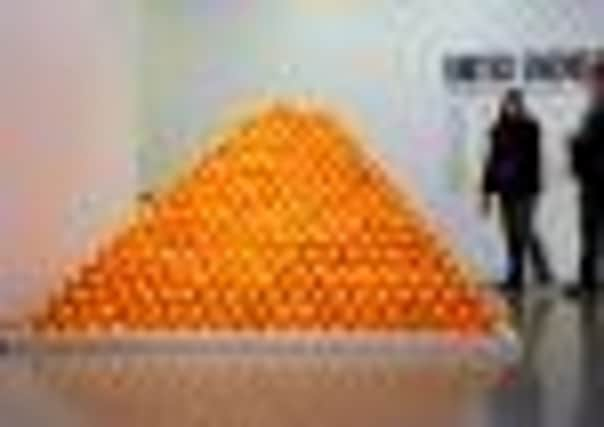Bringing fruits of a sculptor’s genius home to the masses


ART can be good for the mind and soul, but it doesn’t often nourish the body, too. Well, the latest exhibition at the Henry Moore Institute in Leeds certainly does.
The centrepiece of United Enemies: The Problem of Sculpture in Britain in the 1960s and 1970s, is Roelof Louw’s Soul City (Pyramid of Oranges), which has been painstakingly re-created using 6,000 locally-sourced oranges to form a fruit display like nothing you will have ever seen before. But not only is this a feast for the eyes, it’s also one for the taste buds with visitors encouraged to take an orange away with them to eat.
Advertisement
Hide AdAdvertisement
Hide AdThe exhibition, which runs until March next year, is broken down into three themes – Manual Thinking, Standing and Groundwork – and together they are used to explore one of the most experimental periods in British sculpture.
Curator Jon Wood believes Louw’s edible sculpture, which the artist first created in 1967, will intrigue and amuse viewers. “It is the leitmotiv of the show and it sits really nicely with the three themes. The act of placing the oranges by the artist or his assistant and the act of taking them away by the visitor is about using our hands, but it’s also about a standing sculpture that grows from the ground. It’s also a way of the artist giving people a shot of vitamin C, so it’s a very generous gift.”
The exhibition features 62 objects produced by more than 50 British artists from the 60s and 70s.
“There are a lot of artists here that people have perhaps forgotten alongside the more famous names like Anthony Caro and Gilbert and George and it focuses on the artworks rather than the artists, it’s about interesting and quirky objects. It’s also about how can we harness the imagination of the viewer, give them things they can hold, open and eat?”
Advertisement
Hide AdAdvertisement
Hide AdWood says the show includes artists whose work wouldn’t normally be seen together. “It was a bold period for breaking all kinds of boundaries, from social mores through to architecture, and it’s interesting to see the different competing ideas from this era.”
It was a time when the meaning of sculpture itself came into question. “This period was incredibly exciting because the younger generation of artists were questioning whether sculptures had to go on a plinth, and if they had to go on a floor, what kind of floor? Do they need to have a commemorative function, do they have to be permanent, can’t they be ephemeral and throw away?
“All these basic questions about the language and nature of sculpture were being widely asked by artists and the reverberations are still felt today.
“The work of the Damien Hirsts of this world would not have been possible without the breakthroughs that happened during this period.”
Advertisement
Hide AdAdvertisement
Hide AdUnited Enemies: The Problem of Sculpture in Britain in the 1960s and 1970s, Henry Moore Institute, Leeds, to March 11, 2012.
Shaping the future – British sculpture in the 60s and 70s
While the influences of Henry Moore and Barbara Hepworth loom large over British sculpture in the 20th-century, by the late 60s the idea of sculpture itself was being radically contested.
The latest exhibition at the Henry Moore Institute brings together the likes of Sir Anthony Caro, Peter Hide and Gilbert and George.
One of the most compelling exhibits is John Davies’ Three Figures (1971). Strange and disturbing in equal measure, it leaves the viewer with more questions than answers but it creates a powerful visual image which, surely, is the hallmark of all great sculpture.